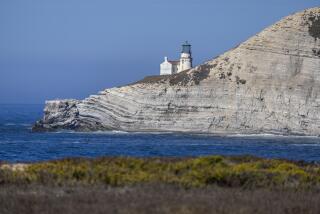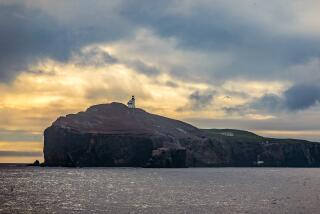Biologist Finds Purpose on His Island Home
- Share via
SANTA CRUZ ISLAND — They say that no man is an island, but Lyndal Lee Laughrin comes close.
He lives and works on a 23-mile-long island off the Ventura County coast. To most people, Santa Cruz Island is a mist-shrouded mystery in the ocean, but to Laughrin, it is his home and his passion. He has been offshore for 36 years--longer than anyone else living there--and has no plans to leave.
Laughrin, a 57-year-old cowboy-turned-biologist, has as intimate a relationship with rugged Santa Cruz as one could have, short of becoming a scrub jay or island fox.
Laughrin is director of the UC Santa Cruz Island Reserve, which is part sanctuary, part laboratory, one of 26 such reserves in California.
He never planned to be on the island this long, but then he cannot recall a time when he wanted off for good.
The only traffic on the 62,000-acre island is an occasional jeep ferrying work crews to one project or another. He drives beneath towering eucalyptus groves planted long ago when Ed Stanton, and later his son, Carey, ran the Santa Cruz Island Co. The Nature Conservancy acquired 90% of the island as a nature preserve in 1988. The truck rumbles past the old sheep shearing shed and the milking barn that, like the chapel, are remnants of the late 19th century, when cowboys lived here and raised sheep and cattle.
“When they started getting a lot of sheepherders out here, I guess they needed to build a church to keep them in line,” Laughrin said, concentrating on the dirt road.
About 1,000 researchers from all over the world come here annually to marvel at the simple but peculiarly diverse ecology. At Santa Cruz, isolation from the mainland has at one time or another produced runt-size mammoths, foxes no bigger than cats and a forest of bishop pines, bonsai-like conifers common to California’s North Coast.
Scientists come to study ants, Indian middens, golden eagles, marine mammals, rocks, nine endemic plants, most anything they can get their hands on.
The hub for all this inquiry is Laughrin’s study center in the great valley, which was formed by an earthquake fault that split the island like an ax blow.
Celebrities from Jane Fonda to Ringo Starr to Barry Goldwater have visited. On one trip, he drove former British Prime Minister Margaret Thatcher to a windy ridge with an entourage of bodyguards.
“Her hair was sprayed to the max, I mean it looked like a helmet,” Laughrin said, chuckling. “We get to the top, and she says, ‘My goodness, it’s so brushy. Is this because of drought?’ So I explained to her that this was a Mediterranean climate and chaparral always looks like this.”
A research partner brought an assistant, Ann Bromfield, whom Laughrin courted and eventually wed in 1986. They spend 80% of their days on the island in a modest tan house with a red roof and no TV or Internet. They enjoy horses, opera, astronomy and sailing to islands around the world and off Mexico.
He took the position in 1970 after spending six years helping as a ranch hand and getting to know the late Carey Stanton. When the previous reserve manager left, Laughrin stepped in as successor.
He earned advanced degrees at UC Santa Barbara, studying island foxes and mockingbirds. Laughrin was looking for a way to stay involved with research while helping students and other scientists and keeping a comfortable distance from university politics and bureaucracy. An island separated from UC Santa Barbara by 25 miles of water seemed the perfect job.
“This isn’t publish-or-perish out here. It was the path of least resistance for me,” Laughrin said.
When the young cowboy from Salinas went to college, he excelled in biology and chemistry, establishing his course as a scientist. Little of that, however, rubbed off on his own son, Jon, who spent much of his youth on the island.
“My son told me a long time ago, ‘Dad, there’s no money in science.’ So he went into construction.”
The diversity and beauty of Santa Cruz captivate him, surprise him and always surrender something more to the trained observer.
“This is my backyard,” said Laughrin, face into the wind, hat brim pulled low over his sunglasses. “That’s why I’ve been here so long. I don’t think it’s possible someone could make me a better offer.”






